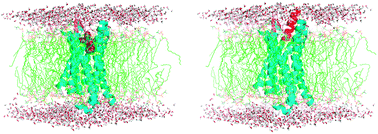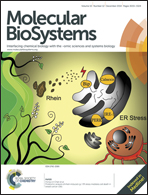The nociceptin receptor (NOPR) and its interaction with clinically important agonist molecules: a membrane molecular dynamics simulation study†
Abstract
The nociceptin receptor (NOPR) is an orphan G protein-coupled receptor that contains seven transmembrane helices. NOPR has a distinct mechanism of activation, though it shares a significant homology with other opioid receptors. Previously there have been reports on homology modeling of NOPR and also molecular dynamics simulation studies for a short period. Recently the crystal structure of NOPR was reported. In this study, we analyzed the time dependent behavior of NOPR docked with clinically important agonist molecules such as NOP (natural agonist) peptide and compound 10 (SCH-221510 derivative) using molecular dynamics simulations (MDS) for 100 ns. Molecular dynamics simulations of NOPR–agonist complexes allowed us to refine the system and to also identify stable structures with better binding modes. Structure activity relationships (SAR) for SCH221510 derivatives were investigated and reasons for the activities of these derivatives were determined. Our molecular dynamics trajectory analysis of NOPR–peptide and NOPR–compound 10 complexes found residues to be crucial for binding. Mutagenesis studies on the residues identified from our analysis could prove useful. Our results could also provide useful information in the structure-based drug design of novel and potent agonists targeting NOPR.


 Please wait while we load your content...
Please wait while we load your content...